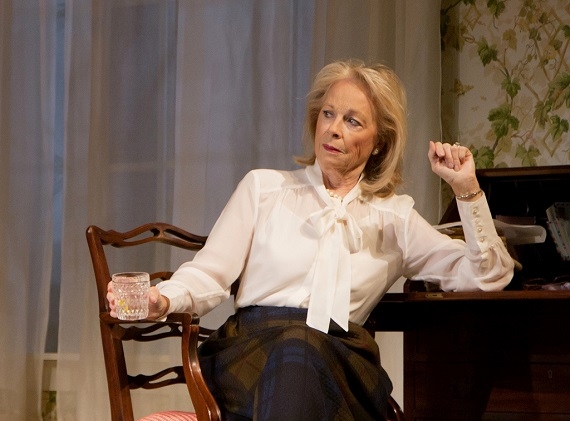The Cocktail Hour

(© T. Charles Erickson)
Eugene O’Neill notwithstanding, the Irish have no corner on all-American, alcohol-fueled recrimination. But as A.R. Gurney demonstrates in his 1988 The Cocktail Hour, the endangered WASP buzzes and flaps with less ferocity. Gurney is, of course, the Brahmin Bard of Buffalo. Much of his considerable oeuvre (including the recently premiered Family Furniture) is set there, where it at once satirizes and exudes a whiff of nostalgia for the “civilized” life of the patrician class of which the now-83-year-old playwright is a scion. The admittedly autobiographical The Cocktail Hour, which is being handsomely revived by Huntington Theatre Company at Boston University Theatre, is no exception: an articulate comedy of familial manners set in the 1970s, it both debunks and blows a kiss to the world of fingerbowls, maid service, and the perfect martini. As cultural commentary, it’s hardly a stiff drink. But despite its 25 years of age, it is as modern, in its metatheatricality, as a craft Cosmo.
John, the Gurney figure (as there tends to be one in each of his plays), is a publishing executive and semiprofessional playwright who has returned to the bosom of his Buffalo family with something of a bomb to slam into that cleavage. Namely, he has written a rather personal play about them — the very folks who raised him to respect privacy along with privilege. It seems that John has always been the family swizzle stick, stirring things up — in this case via the feared if unread play that sits on the coffee table like monogrammed laundry waiting to be aired. And in director Maria Aitken’s droll and polished production, said play is definitely The Cocktail Hour, the one that we are watching. Act one concludes with John onstage alone and scribbling notes, revisions that will figure in this perfected product. Trouble is, John is the play’s least compelling character — perhaps Gurney is too modest to make himself the center. But John comes across as a middle-aged wounded baby more interested in why he was not sufficiently loved than in the anthropology of a crumbling culture. And the boyish James Waterston plays him on a single note of petulant if polite frustration. I am disinclined to blame Waterston; Gurney’s self portrait is surprisingly puerile. He fashions himself as a jealous middle child seeking self-knowledge through glib Freudian analysis.
Well, it’s always about the parents, isn’t it? And in this production, the progenitors are superbly played by Richard Poe and Maureen Anderman, with Pamela J. Gray supplying a solid turn as the self-sacrificing if financially cosseted older sister with a passion for pups and a pretty sharp eye for the psychological goings-on in this particular WASP nest. The bow-tied, magenta-panted Coe captures the ironhanded, avuncular charm of the patriarch who adores holding forth without fear of contradiction and who refuses to see the culture he both embodies and embraces subject to “smart remarks” and public exposure. And in the diaphanous blouse and long bubble of a skirt provided by costume designer Candice Donnelly, the perfectly coiffed Anderman is as tart as the lemon twist in her oft-refreshed martini. Arching an eyebrow, subtly probing cheek with tongue, breezily brushing aside anything as “unattractive” as phallic reference or the theater, she’s a fully fleshed caricature of gracious living.
It is significant to note that Gurney’s The Dining Room was the second play produced by the then-nascent Huntington some 30 years ago. Despite its Pirandellian overtones, this production hearkens back to those well-appointed times on Huntington stages. If, for example, you put a million-dollar price tag on Allen Moyer’s high-ceilinged set, with its burnished furnishings, sylvan wallpaper, and floral prints climbing the stair, some lucky soul with deep pockets would immediately move in. As for the play unfolding there, ever with a wink at itself, it’s an entertaining peek at yesteryear’s 1 percent. But if it has more on its mind than that, even poured into such an elegantglass, it goes down a bit too easy.










